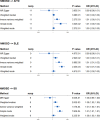The causal relationship between neuromyelitis optica spectrum disorder and other autoimmune diseases
- PMID: 36248893
- PMCID: PMC9562912
- DOI: 10.3389/fimmu.2022.959469
The causal relationship between neuromyelitis optica spectrum disorder and other autoimmune diseases
Abstract
Objectives: The coexistence of neuromyelitis optica spectrum disorder (NMOSD) with other autoimmune diseases has been well recognized. However, the causal association between these two conditions has not been fully studied. The etiology and therapies of NMOSD coexisting with autoimmune diseases also need to be elucidated.
Methods: We performed two-sample Mendelian randomization (MR) analysis to examine the causality. Genome-wide association (GWAS) summary data from NMOSD, autoimmune thyroid disease (AITD), systemic lupus erythematosus (SLE), and Sjogren's syndrome (SS) were used to identify genetic instruments. Causal single-nucleotide polymorphisms (SNPs) were annotated and searched for cis-expression quantitative trait loci (cis-eQTL) data. Pathway enrichment analysis was performed to identify the mechanism of NMOSD coexisting with AITD, SLE, and SS. Potential therapeutic chemicals were searched using the Comparative Toxicogenomics Database.
Results: The MR analysis found that AITD, SLE, and SS were causally associated with NMOSD susceptibility, but not vice versa. Gene Ontology (GO) enrichment analysis revealed that MHC class I-related biological processes and the interferon-gamma-mediated signaling pathway may be involved in the pathogenesis of NMOSD coexisting with AITD, SLE, and SS. A total of 30 chemicals were found which could inhibit the biological function of cis-eQTL genes.
Conclusions: Our findings could help better understand the etiology of NMOSD and provide potential therapeutic targets for patients with coexisting conditions.
Keywords: Mendelian randomization; autoimmune diseases; causal relation; genome-wide associated study; neuromyelitis optica spectrum disorders.
Copyright © 2022 Wang, Shi, Zhao, Chen, Lang, Kong, Lin, Du, Wang and Zhou.
Conflict of interest statement
The authors declare that the research was conducted in the absence of any commercial or financial relationships that could be construed as a potential conflict of interest.
Figures






Similar articles
-
Neuromyelitis Optica Spectrum Disorders (NMOSD) and Connective Tissue Disease (CTD): an Update for the Rheumatologist.Curr Rheumatol Rep. 2021 Apr 28;23(6):33. doi: 10.1007/s11926-021-01000-2. Curr Rheumatol Rep. 2021. PMID: 33909180 Review.
-
The First Case Report of Preschool-Onset SS/SLE Coexisting With NMOSD of Chinese Origin.Front Immunol. 2022 May 2;13:887041. doi: 10.3389/fimmu.2022.887041. eCollection 2022. Front Immunol. 2022. PMID: 35585974 Free PMC article.
-
Nationwide analysis of neuromyelitis optica in systemic lupus erythematosus and Sjogren's syndrome.Clin Rheumatol. 2024 Jan;43(1):59-65. doi: 10.1007/s10067-023-06809-z. Epub 2023 Nov 18. Clin Rheumatol. 2024. PMID: 37980305
-
Genetic Insights into Therapeutic Targets for Neuromyelitis Optica Spectrum Disorders: A Mendelian Randomization Study.Mol Neurobiol. 2025 May;62(5):5518-5530. doi: 10.1007/s12035-024-04612-8. Epub 2024 Nov 20. Mol Neurobiol. 2025. PMID: 39565569
-
Autoimmune diseases associated with Neuromyelitis Optica Spectrum Disorders: A literature review.Mult Scler Relat Disord. 2019 Jan;27:350-363. doi: 10.1016/j.msard.2018.11.008. Epub 2018 Nov 16. Mult Scler Relat Disord. 2019. PMID: 30476871 Review.
Cited by
-
A Case of Neuromyelitis Optica Spectrum Disorder Complicated by Posterior Reversible Encephalopathy Syndrome With Pre-existing Sjögren's Syndrome and Autoimmune Hepatitis.Cureus. 2025 Jan 27;17(1):e78098. doi: 10.7759/cureus.78098. eCollection 2025 Jan. Cureus. 2025. PMID: 40018473 Free PMC article.
-
Neuromyelitis Optica: Pathogenesis Overlap with Other Autoimmune Diseases.Curr Allergy Asthma Rep. 2023 Nov;23(11):647-654. doi: 10.1007/s11882-023-01112-y. Epub 2023 Oct 27. Curr Allergy Asthma Rep. 2023. PMID: 37889429 Review.
-
Vitamin D in Primary Sjogren's Syndrome (pSS) and the Identification of Novel Single-Nucleotide Polymorphisms Involved in the Development of pSS-Associated Diseases.Diagnostics (Basel). 2024 Sep 13;14(18):2035. doi: 10.3390/diagnostics14182035. Diagnostics (Basel). 2024. PMID: 39335717 Free PMC article. Review.
-
[Pregnancy-associated neuromyelitis optical spectrum disorder combined with primary Sjögren's syndrome: A critical illness case report].Beijing Da Xue Xue Bao Yi Xue Ban. 2023 Dec 18;55(6):1118-1124. doi: 10.19723/j.issn.1671-167X.2023.06.025. Beijing Da Xue Xue Bao Yi Xue Ban. 2023. PMID: 38101798 Free PMC article. Chinese.
-
Prediction of apolipoprotein A-I and high-density lipoprotein cholesterol in the neurological impairment and relapse of neuromyelitis optica spectrum disorder.Front Neurosci. 2025 Jul 15;19:1629357. doi: 10.3389/fnins.2025.1629357. eCollection 2025. Front Neurosci. 2025. PMID: 40735294 Free PMC article.
References
-
- Available at: https://www.ebi.ac.uk/gwas/.
-
- Available at: https://shiny.cnsgenomics.com/mRnd/.
Publication types
MeSH terms
Substances
LinkOut - more resources
Full Text Sources
Medical
Research Materials

